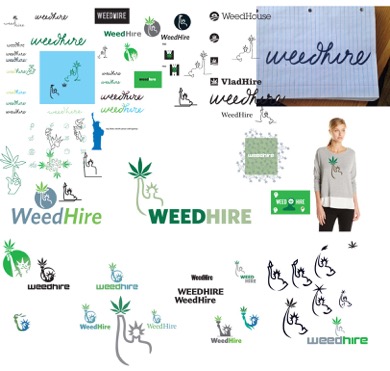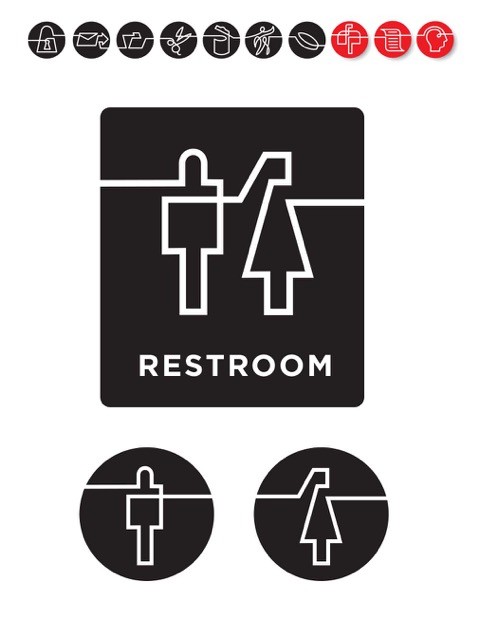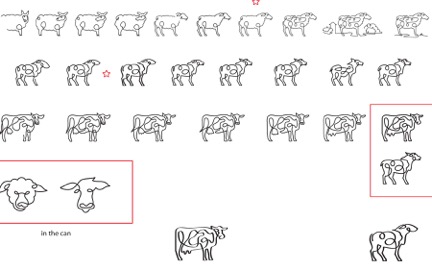Designer/illustrator Felix Sockwell is known for his illustrative, fluid line work. When looking at his pieces it appears that his pen never left the page, as each idea and object is interconnected into a larger narrative. This quick wit and ability to translate seemingly complex ideas into simple, iconographic solutions have gained Sockwell many fans and clients. But it’s not all fun and games. Occasionally, even he hits a wall with a client.
Below, Sockwell walks us through three design projects that were killed, and explains why he believes in reincarnation.
My soccer pal Vlad called and asked me for a “favor,” one in which I did not take to mean as “free” (which would come back to haunt me). He is one of my best friends and most of us on the soccer team consider him wealthy (he wouldn’t). Regardless, he’s a great guy—smart in business and a family man.
He tells me he has a new business called Weedhire, an employment agency for the cannabis industry. He said, “You’re the expert. You tell me what works. Just do something fast.”
What Vlad probably didn’t realize is that designing an identity is kind of intimate, like sex. It takes time. You have to talk. And talk some more. And be honest with one another.
I showed Vlad a few things and his response was to take all the creativity out of it. He said, “Make it look like a bank.” So as I began researching bank logos, I started feeling like a conversation was needed. I picked up the phone and asked if this was intended to be more than a conservative place to find a job in the cannabis industry. I never got a clear response on what the strategy is or was, but by the third day (when I realized I had just wasted a lot of energy doing logos for free), he said he would just have his web designer pop a pot leaf in a box in five minutes. Which is exactly what he did.
I hold no grudge (OK maybe a little, I’m showing the work here), but what struck me about the experience was that some people—good, smart people—care absolutely nothing about how a logo looks or speaks. Design is a HUGE part of your business plan if you’re in the “people” industry. The “lady leaferty” in the center, which I believe to be a smart, conservatively drawn, creative idea, is an idea that I hope someone sees and actually wants to pay for.
Honestly, I can’t do free work for millionaires, but I will do free portraits for bat mitzvahs and charitable offerings.
Back in 1999, I received a job from Roger Black’s digital agency at the time. The job consisted of a range of iconography for a then TBA merger of Bell Atlantic and GTE, soon to be known as Verizon. I begged to draw the new logo, but they said Landor was doing it. Fine.
The word “connected” was described in the brief, so that’s where I went, linking the row of icons strung together with a white line through a circle. They hated it. Killed it immediately. “Weird,” they said.
Well, 15 years later I’m still using the DNA from that one date with Verizon. I’ve even lined up a wayfinding design that I’d like to sell somewhere. Now if I could only find a way to have them kill the $1,243.55 bill they keep sending me for an account I’ve never used.
Pentagram hired me to develop a new logo for a dairy and yogurt company. Initially we explored full-bodied animals, then circled back to heads. They responded strongly to the single heads, and wanted to move forwarded with them with some tweaks to make them look friendlier.
But in the end, the client decided not to rebrand themselves, which is a common occurrence. Back in the Sock drawer these go for a future refurbishing.
The thing about rejection, I’ve learned, is that nothing is finished until you say it is. Have a great idea that people respond to? Keep it. Show it. Refurbish it. Tweak it. Redesign it. Sell it
Oddly once you’ve sold it, it no longer has a life of your intention. The public and the company own it. You have no control over it. It’s done. Over. I’m always more excited about things that are killed, because when they come back to life in another form, they have stories; they’re survivors.






